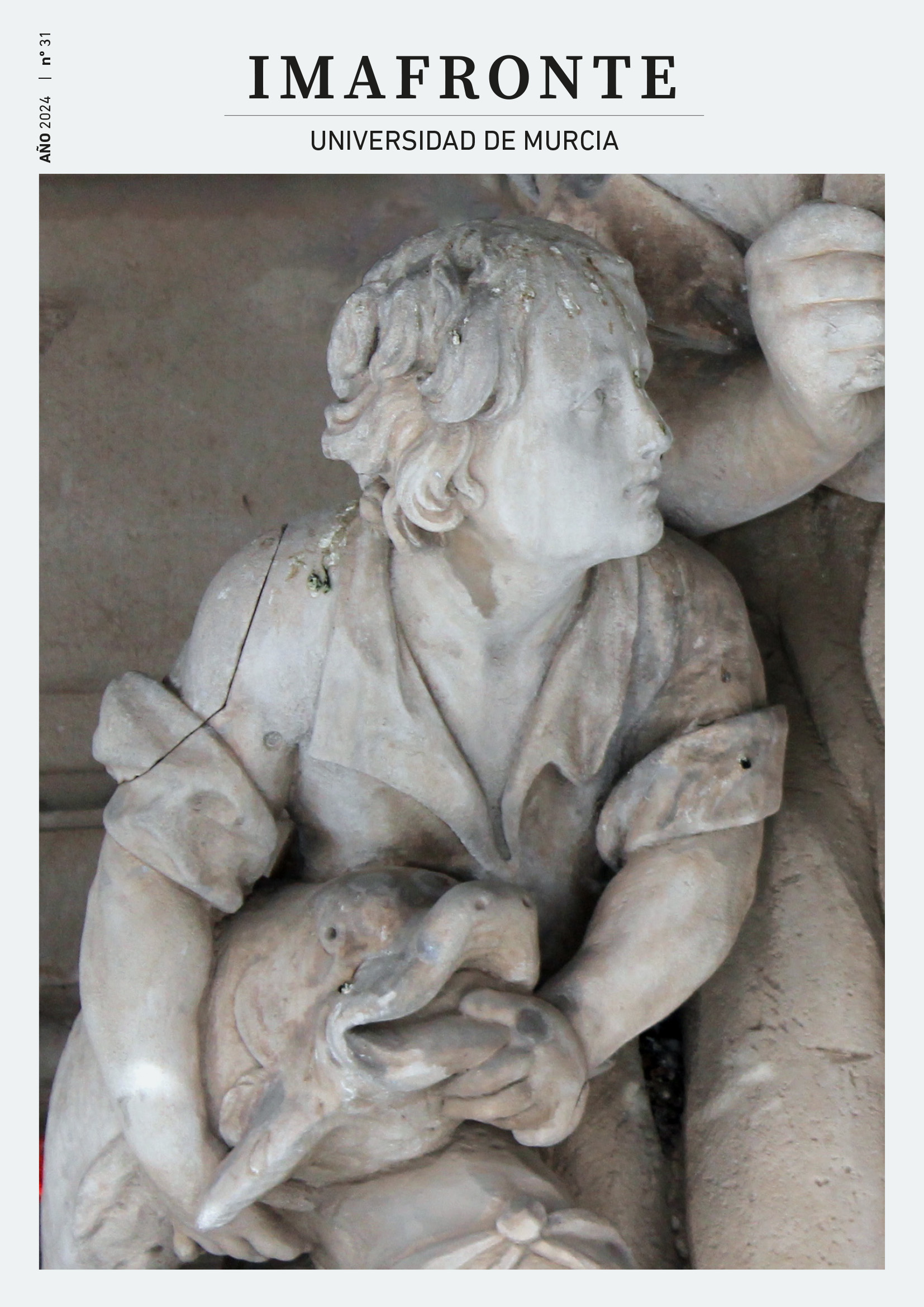Exegesis and Authorial Agency through Judeo-Christian Iconography in Japanese Anime: Neon Genesis Evangelion (1995-97) as an Open Work
Resumen
Exegesis is a common practice when discussing religious texts. It has also been employed in the analysis of cultural production to elucidate the author's intentions. Japanese animation (anime) is a transnational industry with cases such as Neon Genesis Evangelion (1995-1997), in which the figure of an individual author, in this case the filmmaker Hideaki Anno, interacts with the collaborative authorship by the rest of the production team. The extensive use of obscure Judeo-Christian terminology and iconography in this work has risen debate about the actual intentions of Japanese author(s) when referring to Western culture. Our analysis concludes that the use of this iconography is intentional. The ambiguity of the narrative, shaped using multiple obscure references, aims to induce in the viewer the feeling of a complex text. This would reinforce the previous considerations of this anime as an "open work", in the sense defined by post-structural semiotic analysis.
Descargas
-
Resumen1149
-
PDF725
-
EPUB180
Citas
Afasanov, N. (2020) The Depressed Messiah: Religion, Science Fiction, and Postmodernism in Neon Genesis Evangelion. State, Religion and Church 7(1): 47-66.
Agrippa, H. C. (1533) De Occulta Philosophia Vol. 3, Ch. XXX Cologne.
Anno, H. (1996) Anno, 1996 (Animerica panel). http://www.evamonkey.com/writings/animerica-virtual-panel-meet-hideaki-anno.php
Anno, H. (2000a) Interview to Anno in Waseda University, 5-12-2000. https://jinken-official.jimdofree.com/講演録-会見録/庵野秀明-2000/
Anno, H. (2000b) 会見録 [Interview to Hideaki Anno]. Waseda University's People Study Group. https://jinken-official.jimdofree.com/講演録-会見録/庵野秀明-2000/
Anno, H. and Giner, P. (1997) Interview Hideaki Anno. AnimeLand.(32): 19-21.
Azuma, H. (2016) Anime or Something Like it: Neon Genesis Evangelion(E). Intercommunication, 18. (accessed 2016/05/12/).
Barkman, A. (2010) Anime, manga and Christianity: A comprehensive analysis. Journal for the Study of Religions and Ideologies 9(27): 25-45.
Bartoli, F. (2008) Neon Genesis Evangelion e la Kabbalah: dal Tempo di dolore al Tempo Benedetto. Antrocom 4(1): 29-36.
Booker, M. K. (2007) Postmodern Hollywood: What's New in Film and Why It Makes Us Feel So Strange. Westport: Braeger.
Broderick, M. (2002) Anime's Apocalypse: Neon Genesis Evangelion as Millennarian Mecha. Intersections 7: 1-11.
Carruthers, M. J. (2009) Ars oblivionalis, ars inveniendi: The Cherub Figure and the Arts of Memory. Gesta 48(2): 99-117.
Cavallaro, D. (2009) The art of Studio Gainax: experimentation, style and innovation at the leading edge of anime. Jefferson, NC: McFarland.
Chung, S. (2021) Analysis of Evangelion Characters According to the Sephiroth Tree of Life. Eva Monkey, . (accessed 8th April 2021).
Denison, R. (2019) Anime is (not) cult: Gainax and the limits of cult cinema. In: E. Mathijs and J. Sexton (eds) The Routledge Companion to Cult Cinema London: Routledge, pp.121-130.
Didron, A. N. (1907) Christian Iconography: or, the history of Christian art in the Middle Ages, Volume 1: The history of the nimbus, the aureole, and the glory. Representations of the persons of the Trinity. With numerous illustrations,. London: George Bell and sons.
DiTommaso, L. (2014) Apocalypticism and Popular Culture. In: J. J. Collins (ed) The Oxford Handbook of Apocalyptic Literature. Oxford: Oxford University Press, pp.473-510.
Eco, U. (1977) On the contribution of film to semiotics. Quarterly Review of Film Studies 2(1): 1-14.
Eco, U. (1985) "Casablanca": Cult Movies and Intertextual Collage. SubStance 14(2): 3-12.
Eco, U. and Robey, D. (1989) The Open Work. Cambridge, Massachusetts: Harvard University Press.
EVA Production Committe (2018) Neon Genesis Evangelion: TV Animation Production Art Collection. UDON Entertainment Production.
Fludd, R. (1617) Utriusque cosmi maioris scilicet et minoris metaphysica, physica atque technica historia: in duo volumnina secundum cosmi differentiam diuisa. Frankfurt: Theodor de Bry.
FunNIME (2002) FunNIME, March, 2002.
GAINAX. (1997a). [Neon Genesis Evangelion storyboards collection vol. 3]. Tokyo: Fujimi Shobo.
GAINAX. (1997b). [Neon Genesis Evangelion storyboards collection vol. 4]. Tokyo: Fujimi Shobo.
Govinda, A. B. (1937) The psychological attitude of early Buddhist philosophy and its systematic representation according to Abhidamma tradition. Peshawar (Pakistan): Allahabad Law Journal Press.
Hernández-Pérez, M. (2019) Looking into the 'Anime Global Popular' and the 'Manga Media'. Reflections on the Scholarship of a Transnational and Transmedia Industry. Arts 8(57): 1-14.
Hills, M. (2002) Transcultural otaku: Japanese representations of fandom and representations of Japan in anime/manga fan cultures. Media in Transition 2: 10-12.
Iwabuchi, K. (1998) Pure impurity: Japan’s genius for hybridism. Communal/Plural: Journal of Transnational and Cross-cultural Studies 6(1): 71-86.
Izawa, E. (2003) Toshio Okada on the Otaku, Anime History, and Japanese Culture.
Luncheon Talk. MIT website, .
Jameson, F. (1991) Postmodernism, or, the cultural logic of late capitalism. Durham: Duke university press.
Kircher, A. (1653) Oedipi Aegyptiaci Ch. VIII. Rome: Vitale Mascardi.
Knox, S. (2006) Reading the ungraspable double-codedness of The Simpsons. Journal of Popular Film & Television. 72-81.
Lamarre, T. (2009) The anime machine: A media theory of animation. U of Minnesota Press.
Lan, K.-W. (2012) Technofetishism of posthuman bodies: representations of cyborgs, ghosts, and monsters in contemporary Japanese science fiction film and animation. Doctoral thesis (PhD), University of Sussex.
Malone, P. M. (2010) Cruel Angels? Cruel Fathers! Mechademia 5: 346-348.
Napier, S. J. (2002) When the Machines Stop: Fantasy, Reality, and Terminal Identity in "Neon Genesis Evangelion" and "Serial Experiments Lain". Science Fiction Studies 29(3): 418-435.
Napier, S. J. (2005) The Problem of Existence in Japanese Animation. In: The American Philosophical Society (ed) Proceedings of the American Philosophical Society. Philadelphia: The American Philosophical Society, pp.72-79.
Newtype (1996) Newtype, n 11.
Newtype USA (2006) Newtype USA, Dec. 2006.
Okada, T. (1996) Return of the otaking: Toshio Okada at Anime America ’96. J-Pop. (accessed 14th April 2021).
Ortega, M. (2007) My father, he killed me; my mother, she ate me: Self, desire, engendering, and the mother in Neon Genesis Evangelion. Mechademia 2(1): 216-232.
Otakon (2001) Otakon 2001, Neon Genesis Evangelion Frequently Asked Questions, https://www.evaotaku.com/html/evafaq.html
Pașca-Tușa, S. and Popa-Bota, I. (2019) The Byzantine iconic representation of the cherubim: scriptural reference points. Studia Universitatis Babeş-Bolyai–Theologia Orthodoxa.(64): 5-20.
Powell, M. A. (2000) The magi as wise men: re-examining a basic supposition. New Testament Studies 46(1): 1-20.
Rayhert, K. (2018) The postmodern theology of Neon Genesis Evangelion as a criticism. Докса 0(2): 161-170.
Schmidt-Biggemann, W. (2008) Robert Fludd’s Kabbalistic Cosmos. In: D. Hedley and S. Hutton (eds) Platonism at the Origins of Modernity. Dordrecht: Springer, pp.75-92.
Scholem, G. G. (1987) Origins of the Kabbalah. Princeton University Press, NJ: Princeton University Press.
Stam, R., Burgoyne, R. and Flitterman-Lewis, S. (1992) New vocabularies in film semiotics: structuralism, post-structuralism, and beyond. Psychology Press.
Standish, I. (1998) Akira, postmodernism and resistance. In: D. P. Martínez (ed) The worlds of Japanese popular culture: Gender, shifting boundaries and global cultures. Cambridge: Cambridge University Press, pp.56-74.
Tanaka, M. (2014) Apocalypse in Contemporary Japanese Science Fiction. New York: Palgrave MacMillan.
Thomas, J. B. (2012) Drawing on Tradition: Manga, Anime, and Religion in Contemporary Japan. Honolulu: University of Hawai’i Press.
Derechos de autor 2024 Manuel Hernandez Perez, Víctor Sellés de Lucas

Esta obra está bajo una licencia internacional Creative Commons Atribución-CompartirIgual 4.0.
Las obras que se publican en esta revista están sujetas a los siguientes términos:
1. Los autores ceden de forma no exclusiva a la revista los derechos de explotación (reproducción, distribución, comunicación y transformación).
2. Las obras que se publican en esta revista están sujetas a la licencia Attribution-ShareAlike 4.0 International (CC By SA 4.0). Por lo que se pueden copiar, usar, difundir, transmitir y exponer públicamente, siempre que:
i) se cite la autoría y la fuente original de su publicación (revista, editorial y URL de la obra), permitiendo así su reconocimiento.
ii) se permite remezclar, transfromar o crear a partir del material mientras se mantenga la misma licencia del original.
3. Condiciones de auto-archivo. Se permite y se anima a los autores a difundir electrónicamente las versiones pre-print (versión antes de ser evaluada) y/o post-print (versión evaluada y aceptada para su publicación) de sus obras antes de su publicación, ya que favorece su circulación y difusión más temprana y con ello un posible aumento en su citación y alcance entre la comunidad académica. Color RoMEO: verde.
























